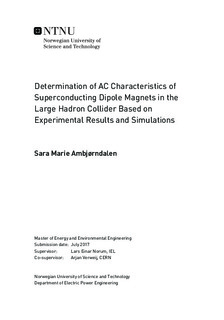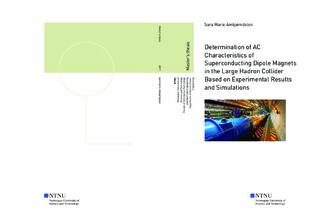| dc.description.abstract | The Large Hadron Collider (LHC) utilizes superconducting Main Dipole Magnets that bend the trajectory of the beam. The LHC ring is electrically divided into eight octants, each allocating a 7 km chain of 154 Main Dipole Magnets. Dedicated detection and protection systems prevent irreversible magnet damage caused by quenches. Quench is a local transition from the superconducting to the normal conducting state. Triggering of such systems, along with other failure scenarios, result in fast transient phenomena. In order to analyze the consequence of such electrical transients and failures in the dipole chain, one needs a circuit model that is validated against measurements.
Currently, there exists an equivalent circuit of the Main Dipole Magnet resolved at an aperture level. Each aperture model takes into account the dynamic effects occurring in the magnets, trough a lossy-inductance model and parasitic capacitances to ground. At low frequencies the Main Dipole Magnet behaves as a linear inductor. Cable eddy current losses are demonstrated by a flattening of the transfer function impedance in the 30 − 50 Hz range. The time constant of such losses is dictated by the parallel resistance, and the relative size of the loss is given by a scaling parameter. Capacitive effects become dominant around 10 kHz. Across the dipole magnet there is a resistor connected in parallel to dampen voltage waves.
Simulations of an Main Dipole Magnet in OrCAD Cadence PSpice, using the present parameters, and measurements from the LHC give a clear discrepancy. This necessitated an updated fit and three methods tailored to obtain each parameter were developed. Firstly, the inductance value was obtained estimated from the initial slope of the impedance plot. Secondly, the numerical method chosen for the parameter fit is Particle Swarm Optimization. The algorithm iteratively minimizes the error between measurements and the analytical impedance transfer function, making it possible to estimate the value of the parallel resistor and the scaling factor. Finally, parasitic capacitance to ground was determined with Finite Element Method in COMSOL, as it is challenging to extract parameters from high frequency measurements. Values from measurements verify this method of estimating capacitance.
The measurements of the Main Dipole Magnets were performed while connected to the rest of the dipole magnet chain, which influenced frequency response measurements. Hence a proposal on how to reduce the sensitivity to this influence is outlined. Moreover, the method of fitting was found to be modular, meaning each Main Dipole Magnet can be fitted individually in the dipole magnet chain. This is significant as it is not necessarily possible to perform measurements on a stand-alone magnet. To crosscheck the validity of the method, Particle Swarm Optimization fits from stand-alone measurements and measurements from the dipole magnet chain were compared. Both values of the parallel aperture resistance and scaling factor were different for the two cases.
Compared to the operating point of the Main Dipole Magnet, measurements were performed at 1 A, resulting in 20 % lower inductance than nominal value. Through COMSOL simulations persistent magnetization was found to be the dominating cause. Furthermore, at 1 A the magnet is in the so-called Meissner phase, creating nonlinearites in the persistent magnetization. Simulations indicate that this distorts the mid-range frequency AC characteristics represented by the parallel aperture resistance and scaling factor. However, measurements outside the Meissner phase are expected to provide similar parameters values to that of the working point of the LHC. Overall, the approach presented has shown promising results and can be translated to a general Section method for fitting electrical parameters for accelerator magnets. | |

